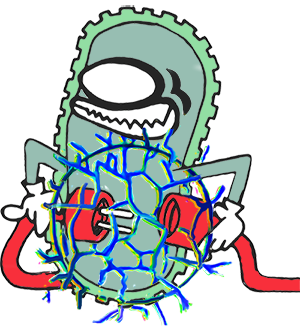Team:TU Delft-Leiden/WetLab/landmine/cloning/yqjF
From 2014.igem.org
Joanctd.igem (Talk | contribs) (Created page with "{{CSS/Delft2014_main}} {{CSS/960_12_col}} {{:Team:TU_Delft-Leiden/Templates/Start}} <html> <!--PAGE CONTENT-----------------> <h2> Landmine Module - Cloning - y...") |
Joanctd.igem (Talk | contribs) |
||
| (2 intermediate revisions not shown) | |||
| Line 11: | Line 11: | ||
<p> | <p> | ||
| + | Two final constructs are based on the yqjF promoter alone: | ||
| + | <a href="http://parts.igem.org/Part:BBa_K1316003" style="text-decoration: none"" target="_blank"><font color="#0080FF" size="3">BBa_K1316003</font></a> | ||
| + | and | ||
| + | <a href="http://parts.igem.org/Part:BBa_K1316003" style="text-decoration: none"" target="_blank"><font color="#0080FF" size="3">BBa_K1316005</font></a>. | ||
| + | For both of them the reporter gene mKate2 needs to be present behind the yqjF promoter. As BBa_K1316005 was built on bases of BBa_K1316003, a double transcriptional terminator was designed to be after the mKate2 gene. Otherwise, the RNA polymerase would continue transcribing and some unfinised transcripts of the N-genes could interfere with the normal expression of these genes. Therefore, mKate2 gene was first PCRed out of a comercial plasmid and introduced in front of a Double terminator ( | ||
| + | <a href="http://parts.igem.org/Part:BBa_K823017" style="text-decoration: none"" target="_blank"><font color="#0080FF" size="3">BBa_K823017</font></a> | ||
| + | ). | ||
| + | <p> | ||
| + | The yqjF land mine promoter was PCRed out of the plasmid obtained from Belkin's lab [1] and cloned in front of mKate2. | ||
| + | </p> | ||
| + | |||
| + | <p> | ||
| + | The construct | ||
| + | <a href="http://parts.igem.org/Part:BBa_K1316003" style="text-decoration: none"" target="_blank"><font color="#0080FF" size="3">BBa_K1316005</font></a> | ||
| + | contains three genes (N-genes) assumed to be involved in the degradation of nitrogene compounds and, therefore, it was hypothesised that they could enhance the action of the used promoters (yqjF and ybiJ). These genes were synthesised "de novo" and cloned behind the double terminator. These genes were designed under the regulation of the Rhamnose inducible promoter, so that the influence of these N-genes can be easily tested. | ||
| + | </p> | ||
| + | <p> | ||
<img src="https://static.igem.org/mediawiki/2014/9/96/TUDelft_Land_Mine_pF_Final_LandMines_History.png" width="100%" height="100%"> | <img src="https://static.igem.org/mediawiki/2014/9/96/TUDelft_Land_Mine_pF_Final_LandMines_History.png" width="100%" height="100%"> | ||
| + | </p> | ||
| + | <h3> References </h3> | ||
| + | <p>[1] S. Yagur-Kroll, S. Belkin <i>et al.</i>, “<i>Escherichia Coli</i> bioreporters for the detection of 2,4-dinitrotoluene and 2,4,6-trinitrotoluene”, Appl. Microbiol. Biotechnol. 98, 885-895, 2014. </p> | ||
</html> | </html> | ||
{{:Team:TU_Delft-Leiden/Templates/End}} | {{:Team:TU_Delft-Leiden/Templates/End}} | ||
Latest revision as of 13:34, 30 September 2014
Landmine Module - Cloning - yqjF promoter
yqjF promoter
Two final constructs are based on the yqjF promoter alone: BBa_K1316003 and BBa_K1316005. For both of them the reporter gene mKate2 needs to be present behind the yqjF promoter. As BBa_K1316005 was built on bases of BBa_K1316003, a double transcriptional terminator was designed to be after the mKate2 gene. Otherwise, the RNA polymerase would continue transcribing and some unfinised transcripts of the N-genes could interfere with the normal expression of these genes. Therefore, mKate2 gene was first PCRed out of a comercial plasmid and introduced in front of a Double terminator ( BBa_K823017 ).
The yqjF land mine promoter was PCRed out of the plasmid obtained from Belkin's lab [1] and cloned in front of mKate2.
The construct BBa_K1316005 contains three genes (N-genes) assumed to be involved in the degradation of nitrogene compounds and, therefore, it was hypothesised that they could enhance the action of the used promoters (yqjF and ybiJ). These genes were synthesised "de novo" and cloned behind the double terminator. These genes were designed under the regulation of the Rhamnose inducible promoter, so that the influence of these N-genes can be easily tested.

References
[1] S. Yagur-Kroll, S. Belkin et al., “Escherichia Coli bioreporters for the detection of 2,4-dinitrotoluene and 2,4,6-trinitrotoluene”, Appl. Microbiol. Biotechnol. 98, 885-895, 2014.
 "
"






